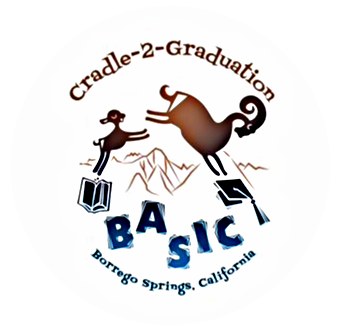BASIC's Four-Part Cradle-to-Graduation Program (C2G)
For a brief overview of the four aspects of BASIC's C2G program, please watch our slideshow below.
Our Facts
Our thinking has been influenced by research done by others and independently validated. (See linked references below.)
- Reading to very young children stimulates brain activity and contributes to school performance.
- Owning and displaying books at home is one of the best—and easiest—ways a family can nurture academic success.
- Recognizing that the 3rd grade is a critical milestone is key. A student who is not reading at grade level at the end of the 3rd grade is four times more likely to drop out of high school. Add poverty to the mix, and a student is 13 times more like to drop out.
- Middle school math competency is essential for high school success and determines the lifetime income of the student.
- Students who do not continue their education beyond high school are economically disadvantaged for their whole lives, diminishing national productivity.
Our Hope
BASIC is committed to providing educational opportunities which will augment our students’ classroom experiences.
We want to help our students move up academically into the mainstream.
Originally, we focused our attention on the college-bound student, but we came to realize that the real concern and time for intervention lay earlier: reading, writing, and arithmetic in the grades leading up to high school graduation. This was the inception of BASIC’s “C2G” campaign—a five-part Cradle-to-Graduation Program.
We want to help our students move up academically into the mainstream.
Originally, we focused our attention on the college-bound student, but we came to realize that the real concern and time for intervention lay earlier: reading, writing, and arithmetic in the grades leading up to high school graduation. This was the inception of BASIC’s “C2G” campaign—a five-part Cradle-to-Graduation Program.
Our Approach & Plan
A two-year, in-depth review, based on best-practices and peer-reviewed research (see linked references below),
lead to the creation of BASIC’s Cradle-to-Graduation Program. This C2G Program consists of four parts:
lead to the creation of BASIC’s Cradle-to-Graduation Program. This C2G Program consists of four parts:
- Putting books in the hands of preschoolers. Kindergarten readiness improves, and positive effects are measurable thereafter. BASIC partners with Dolly Parton’s Imagination Library to ensure that enrolled children receive a free, age-appropriate book monthly, delivered to their homes, from birth until age 5. There are now over 100 children benefiting from this program in Borrego.
- Reinforcing early literacy education in Latino families via the Latino Family Literacy Program.
- Intervening in the elementary school. BASIC’s Summer Learning Academy helps students to move toward reading at grade level. More than 50% of Borrego’s 3rd grade students failed California’s statewide proficiency exam in 2016. The 3rd grade is critical as the students transition from “learning to read” to “reading to learn” for the rest their school years. Since 2017, we have supported the summertime Learning Academy for 2nd and 3rd graders and launched a third literacy class for older children; since the summer of 2018, we have also held a math class for middle school students.
- Offering scholarships to high school graduates who wish to continue their education, as well as to adults desiring to return to school. Applicants fall into two categories: Start-School scholars and Stay-in-School scholars. All applicants are reviewed by a committee of professional educators.


